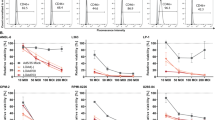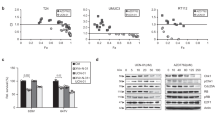Abstract
The diverse advanced treatment modalities currently available to children with medulloblastoma, including surgery and radiotherapy, are associated with deleterious side effects and often with an unfavorable prognosis. A mutant adenovirus, Delta-24, which has a 24-base pair deletion in the Rb-binding region of the E1A gene, demonstrates selective replication and oncolysis in various malignant phenotypes. Here we report the ability of Delta-24 to kill medulloblastoma cells. Flow cytometric analyses of cell receptors demonstrated expression of the coxsackie adenovirus receptor and RGD-related integrins in the assessed medulloblastoma cell lines. Infectivity assays using a replication-deficient adenovirus to transduce the green fluorescence protein gene showed that the Delta-24 adenovirus infects 99% of Daoy and 46% of D283 Med medulloblastoma cells at a multiplicity of infection (MOI) of 50. Within 4 days after infecting medulloblastoma cells with Delta-24, a noticeable cytopathic effect was produced. Delta-24 induced a total cytopathic effect in Daoy and D283 Med medulloblastoma cells after 6 and 8 days of infection, respectively. In the infected population of cells, cell death correlated with the accumulation of cells in the S phase. At 5 days post-infection with 2.5 MOIs of Delta-24 adenovirus, the percentage of Daoy medulloblastoma cells in the S phase increased to 71.9±5.5%, compared with control values of 20.5±1.4%. The release of viral progeny was quantified as being increased by two orders of magnitude, indicating efficient replication of Delta-24 in medulloblastoma cells. This is the first report of the ability of oncolytic adenoviruses to infect and kill medulloblastoma cells, the findings of which suggest the potential efficacy of Delta-24 as a therapy for human medulloblastoma tumors.
This is a preview of subscription content, access via your institution
Access options
Subscribe to this journal
Receive 12 print issues and online access
$259.00 per year
only $21.58 per issue
Buy this article
- Purchase on Springer Link
- Instant access to full article PDF
Prices may be subject to local taxes which are calculated during checkout




Similar content being viewed by others
References
Ellison DW, Clifford SC, Gajjar A, Gilbertson RJ . What's new in neuro-oncology? Recent advances in medulloblastoma. Eur J Paediatr Neurol. 2003;7:53–66.
Packer RJ, Rood BR, MacDonald TJ . Medulloblastoma: present concepts of stratification into risk groups. Pediatr Neurosurg. 2003;39:60–67.
Mazzola CA, Pollack IF . Medulloblastoma. Curr Treat Options Neurol. 2003;5:189–198.
Xu W, Janss A, Moshang T . Adult height and adult sitting height in childhood medulloblastoma survivors. J Clin Endocrinol Metab. 2003;10:4677–4681.
Chiocca EA . Oncolytic viruses. Nat Rev Cancer. 2002;2:938–950.
Bischoff JR, Kirn DH, Williams A, et al. An adenovirus mutant that replicates selectively in p53-deficient human tumor cells. Science. 1996;274:373–376.
Fueyo J, Gomez-Manzano C, Alemany R, et al. A mutant oncolytic adenovirus targeting the Rb pathway produces anti-glioma effect in vivo. Oncogene. 2000;19:2–12.
Fueyo J, Alemany R, Gomez-Manzano C, et al. Preclinical characterization of the antiglioma activity of a tropism-enhanced adenovirus targeted to the retinoblastoma pathway. J Natl Cancer Inst. 2003;95:652–660.
Heise C, Hermiston T, Johnson L, et al. An adenovirus E1A mutant that demonstrates potent and selective systemic anti-tumoral efficacy. Nat Med. 2000;10:1134–1139.
Yang WQ, Senger D, Muzik H, et al. Reovirus prolongs survival and reduces the frequency of spinal and leptomeningeal metastases from medulloblastoma. Cancer Res. 2003;12:3162–3172.
Gomez-Manzano C, Fueyo J, Kyritsis AP, et al. Adenovirus-mediated transfer of the p53 gene produces rapid and generalized death of human glioma cells via apoptosis. Cancer Res. 1996;4:694–699.
Fueyo J, Gomez-Manzano C, Yung WK, et al. Overexpression of E2F-1 in glioma triggers apoptosis and suppresses tumor growth in vitro and in vivo. Nat Med. 1998;6:685–690.
Alemany R, Dai Y, Lou YC, et al. Complementation of helper dependent adenoviral vectors: size effects and titer fluctuations. J Virol Methods. 1997;68:147–157.
Alemany R, Ruan S, Kataoka M, et al. Growth inhibitory effect of anti-K-ras adenovirus on lung cancer cells. Cancer Gene Ther. 1996;5:296–301.
Jones N, Shenk T . Isolation of adenovirus type 5 host range deletion mutants defective for transformation of rat embryo cells. Cell. 1979;3:683–689.
Skog J, Mei YF, Wadell G . Human adenovirus serotypes 4p and 11p are efficiently expressed in cell lines of neural tumour origin. J Gen Virol. 2002;83:1299–1309.
Kenney AM, Cole MD, Rowitch DH . Nmyc upregulation by sonic hedgehog signaling promotes proliferation in developing cerebellar granule neuron precursors. Development. 2003;130:15–28.
Berman DM, Karhadkar SS, Hallahan AR . Medulloblastoma growth inhibition by hedgehog pathway blockade. Science. 2002;5586:1559–1561.
Oliver TG, Grasfeder LL, Carroll AL . Transcriptional profiling of the Sonic hedgehog response: a critical role for N-myc in proliferation of neuronal precursors. Proc Natl Acad Sci USA. 2003;12:7331–7336.
Rao G, Pedone CA, Coffin CM, Holland EC, Fults DW . c-Myc enhances sonic hedgehog-induced medulloblastoma formation from nestin-expressing neural progenitors in mice. Neoplasia. 2003;3:198–204.
Marino S, Vooijs M, van Der Gulden H, Jonkers J, Berns A . Induction of medulloblastomas in p53-null mutant mice by somatic inactivation of Rb in the external granular layer cells of the cerebellum. Genes Dev. 2000;8:994–1004.
Lamfers ML, Grill J, Dirven CM, et al. Potential of the conditionally replicative adenovirus Delta-24RGD in the treatment of malignant gliomas and its enhanced effect with radiotherapy. Cancer Res. 2002;62:5736–5742.
Acknowledgements
We thank Joann Aaron for editorial assistance (Department of Neuro-Oncology, MD Anderson Cancer Center). This work was supported by grants from the Pediatric Brain Tumor Foundation of the United States, the National Institutes of Health R01CA90879, and the Anthony Bullock Foundation.
Author information
Authors and Affiliations
Corresponding author
Rights and permissions
About this article
Cite this article
Stolarek, R., Gomez-Manzano, C., Jiang, H. et al. Robust infectivity and replication of Delta-24 adenovirus induce cell death in human medulloblastoma. Cancer Gene Ther 11, 713–720 (2004). https://doi.org/10.1038/sj.cgt.7700731
Received:
Published:
Issue Date:
DOI: https://doi.org/10.1038/sj.cgt.7700731
Keywords
This article is cited by
-
Reduction of nontarget infection and systemic toxicity by targeted delivery of conditionally replicating viruses transported in mesenchymal stem cells
Cancer Gene Therapy (2010)
-
E1A-expressing adenoviral E3B mutants act synergistically with chemotherapeutics in immunocompetent tumor models
Cancer Gene Therapy (2008)



